Checking Traceability Across Models
Overview
The Trace View is the screen for checking traceability between models. The tree-based Trace View allows you to arrange hierarchical models and check traceability and the scope of impact across multiple models.
The following explains how to check traceability across models in the following order:
- Switching screens
- Arranging target models
- Narrowing the scope of traceability checks
- Checking traceability across models
- Narrowing the target models to display
- Checking trace coverage for each target model
Switching screens
To display the Trace View, follow these steps:
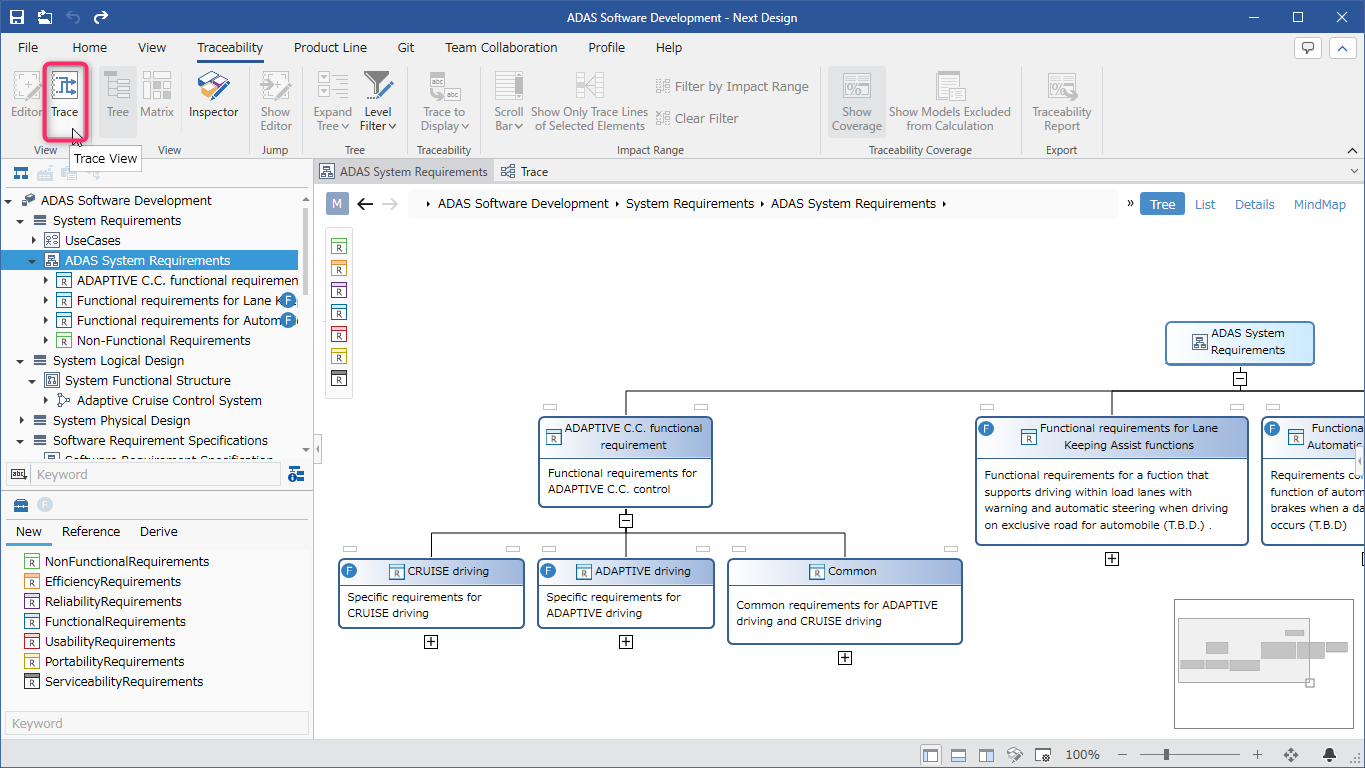
- From the ribbon, do one of the following:
- Click [Home] > [View] > [Trace] on the ribbon.
- Click View > View > Trace on the ribbon.
- Click Traceability > View > Trace on the ribbon.
- To return to the editor page where you edit your model, do one of the following:
- Click Home > View > Editor on the ribbon.
- Click View > View > Editor on the ribbon.
- Click Traceability > View > Editor on the ribbon.
- The first time you view the Trace View, it will appear in a new tab.
If you already have the Trace View open, it will appear in that tab. You cannot view the Trace View in multiple tabs.
-
The Trace View does not automatically refresh when you edit a model in the editor.
When you edit a model in the editor, a refresh notification and button will appear in the Trace View.
Click the refresh button manually.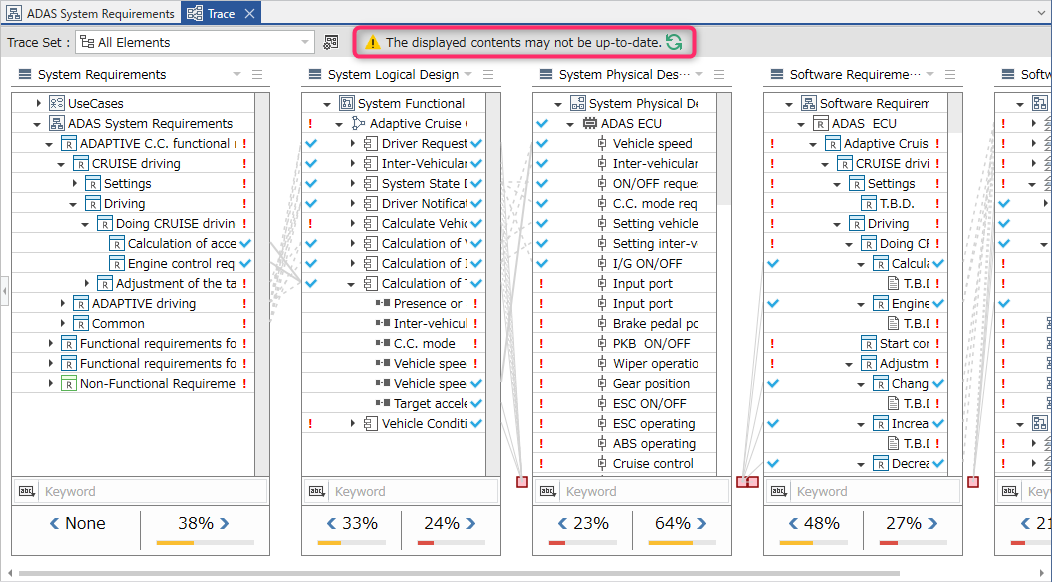
-
The Trace View can be docked or displayed as a floating window.
For instructions on docking and floating window display, see Model Editing > Model Editing Basics > Opening and Editing Multiple Models Simultaneously.
Arranging the Target Models
To add a lane to the Trace View and arrange the target models, follow these steps:

:::note: Instructions
- Execute the [Add Lane] command from the menu button in the upper right corner of each lane to display the model hierarchy in a tree view.
- Select a model from the tree view. A lane will be added to the right, displaying the selected model.
:::
- Even if a model has a derivation relationship recorded, trace lines will not be displayed if the model displayed in the lane to the right is not the derivation destination of the derivation relationship.
To change the model displayed in a lane, follow the steps below.
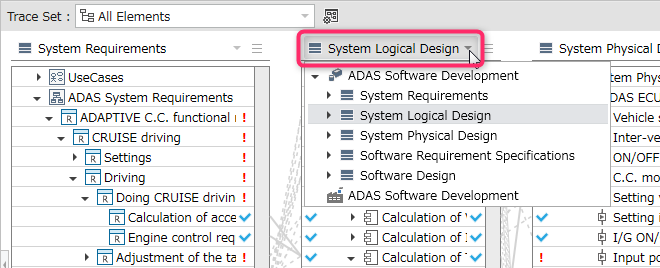
- Change the model displayed in the lane by changing the model from the drop-down list at the top of each lane.
To change the order of lanes, follow the steps below.
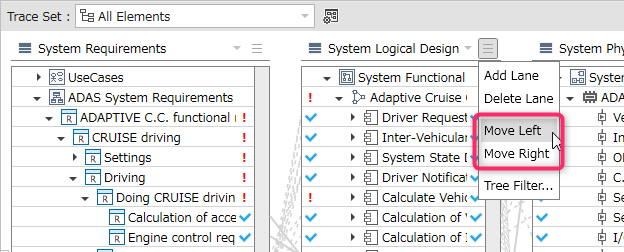
- Use the [Move Left] or [Move Right] command from the menu button in the upper right corner of each lane to swap the order with the lane to the left or right.
Narrowing the Traceability Check Target
To narrow the traceability check target elements by metamodel entities and hide unnecessary elements in the trace view, follow these steps:
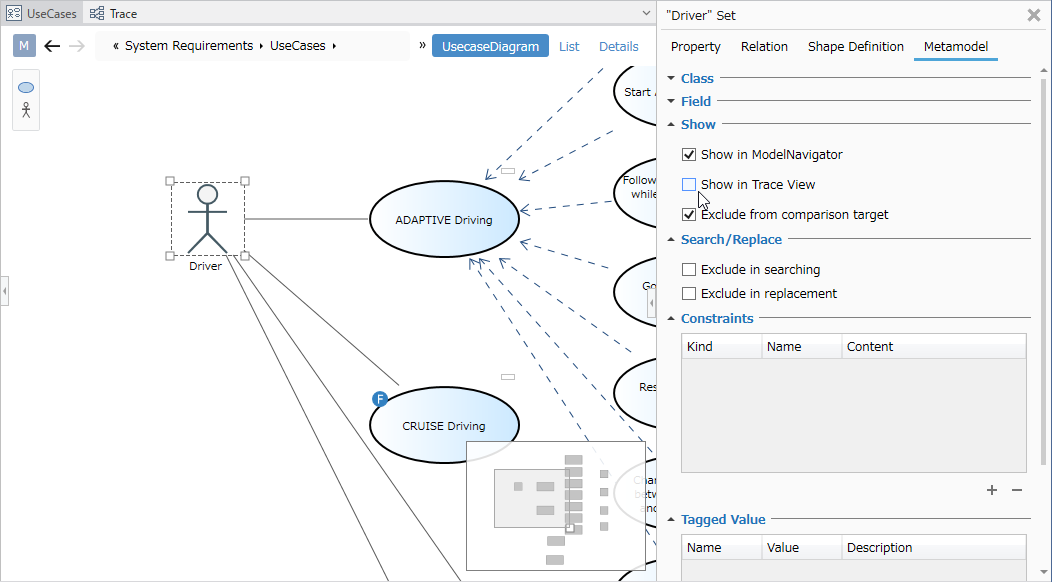
- Return to the editor page and select the model you want to hide in the trace view.
- Click View > Pane > Inspector on the ribbon to display the Inspector.
- Select the Metamodel tab at the top of the Inspector.
- Uncheck the Show in Trace View checkbox in the View group.
- When you switch to the trace view, elements corresponding to the same entity will no longer be displayed in the lane. They will also be excluded from the coverage calculation.
Checking Traceability Across Models
To check traceability and scope of impact across the target model, starting from any element displayed in a lane, follow these steps:
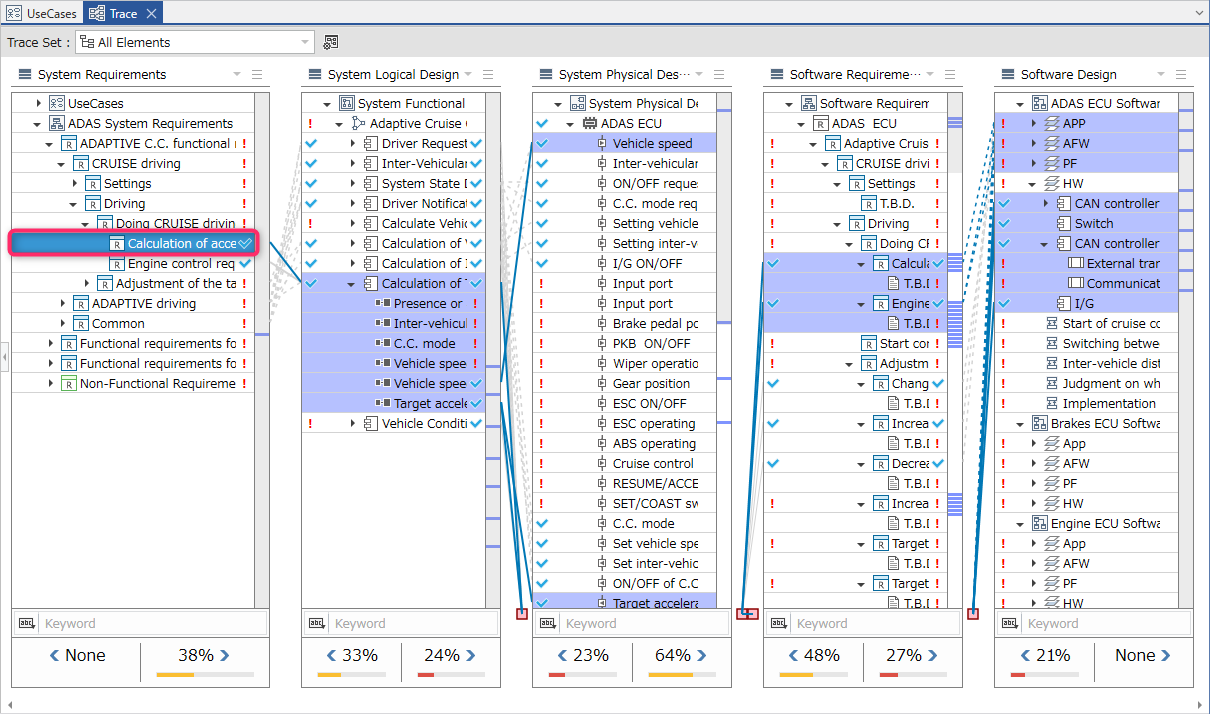
- Click a model element displayed in a lane. Related elements are highlighted based on the element's derived relationships and hierarchical structure.
- Expand the tree in each lane as needed to view details for each child element.
The icons displayed on the lane have the following meanings:
| Icon Location | Meaning |
|---|---|
| Rightmost | Whether the element is a derived source of derived relationships |
| Leftmost | Whether the element is a derived destination of derived relationships |
| Icon Type | Meaning |
|---|---|
| One or more derived relationships exist | |
| No derived relationships exist | |
| Not included in trace coverage calculation | |
| No Icon | The element itself cannot have derived relationships, but has a parent element that has descendants that can have derived relationships |
Icons displayed outside the lane have the following meanings:
| Icon Type | Meaning |
|---|---|
| Derivation destination/source is outside the display range |
If there is a derivation relationship between elements on adjacent lanes, a trace line will be displayed between the lanes. The types of trace lines that can be displayed are as follows:
| Line Type | Meaning |
|---|---|
| Solid | A trace line between elements whose metamodels are directly related. (Example: A trace line between elements whose tree is expanded in adjacent lanes.) |
| Dot | A trace line between elements whose metamodels are indirectly related. (Example: A trace line between elements whose tree is collapsed in one of adjacent lanes.) |
- To hide trace lines between child elements (dotted lines) and only display trace lines between elements (solid lines), disable [Traceability] > [Traceability] > [Trace to Display] > [Show Indirect Trace] from the ribbon.
- To display both dotted and solid lines, enable [Traceability] > [Traceability] > [Trace to Display] > [Show Indirect Trace] from the ribbon.
- To display only trace lines for selected elements, select [Traceability] > [Impact Range] > [Show Only Trace Lines of Selected Elements] from the ribbon.
The scroll bar displays the locations of elements in models related to the selected element.
Note
- To hide the locations of elements in models related to the selected element, disable [Traceability] > [Impact Range] > [Scroll Bar] > [Show Impact Range] from the ribbon.
Filtering the Displayed Target Models
To filter the displayed target models starting from the selected element and check the traceability and impact range, follow the steps below.
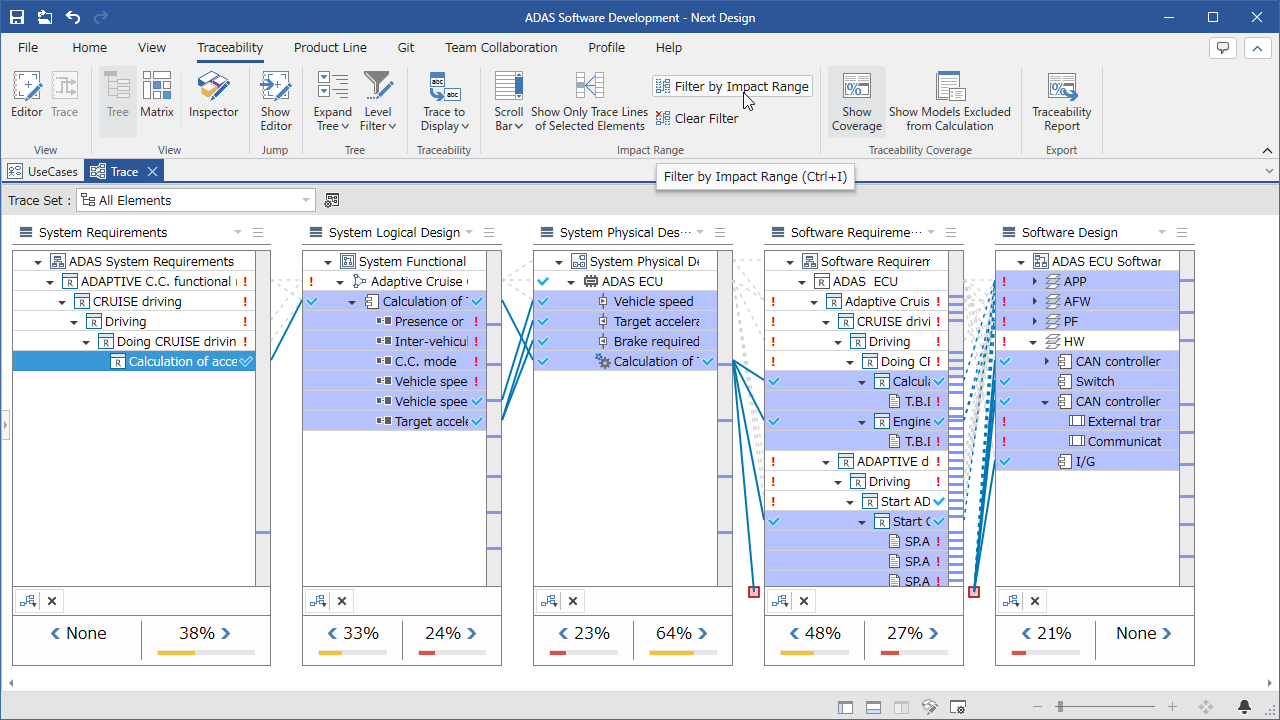
Note
- Select the starting element from the models displayed on the lane.
- Based on the derivation relationships and hierarchical structure of the selected element, related elements are highlighted. Click the [Traceability] > [Impact Range] > [Filter by Impact Range] button on the ribbon.
- Only the highlighted related elements will be displayed in the lane.
In addition to [Filter by Impact Range], Next Design offers the following methods for narrowing the displayed target models.
These methods are available from the buttons displayed at the bottom of each lane.
- Keyword Filter
- Elements with no Derivation Source/Elements with no Derivation Destination
Note that only one of these filter methods can be applied at a time.
- You can update the filter by selecting a different model while in [Filter by Impact Range] and clicking the [Filter by Impact Range] button again.
- You can clear the filter by clicking the [Clear Filter] button during [Filter by Impact Range].
Checking Trace Coverage for Each Target Model
The percentage displayed at the bottom of each lane indicates the trace coverage rate for the source (left) and destination (right).
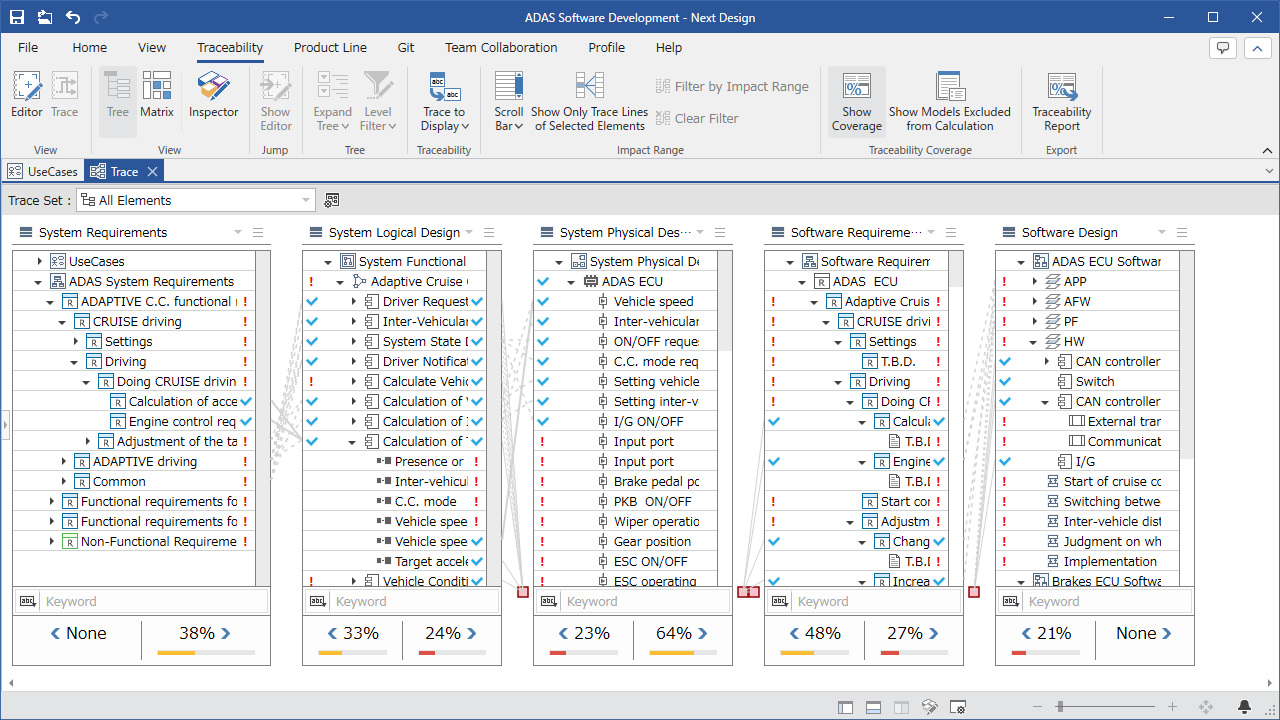
- Coverage is calculated for each lane for each trace direction (source/destination) using the following formula:
Coverage Rate = Number of Elements with One or More Derived Relationships/Number of Elements that Can Have Derived Relationships
- If an element itself cannot have derived relationships but its descendants can, it will be displayed as a parent element in the lane tree, but will not be included in the denominator of the calculation.
- The percentage is rounded to the nearest whole number. However, if it is less than 1%, it will be rounded up to 1%, and if it is greater than 99% but less than 100%, it will be rounded down to 99%.
- Calculation is based on trace configuration information and product application status.
- If an element can have multiple derived relationships in the same trace direction, the coverage rate will be calculated assuming that the element has a derived relationship if any one of these relationships exists.
- For example, if a requirements model can have two derived relationships, one with a design model and one with a test case model, the coverage rate will be calculated assuming that the element has a derived relationship even if the former relationship does not exist.
If you want to check the coverage for only one type of derivation relation, select only the derivation relation you want to check by following the steps in Modeling > Traceability Check > Specify Trace Lines to Check.
To exclude specific elements from the trace coverage calculation, follow these steps:
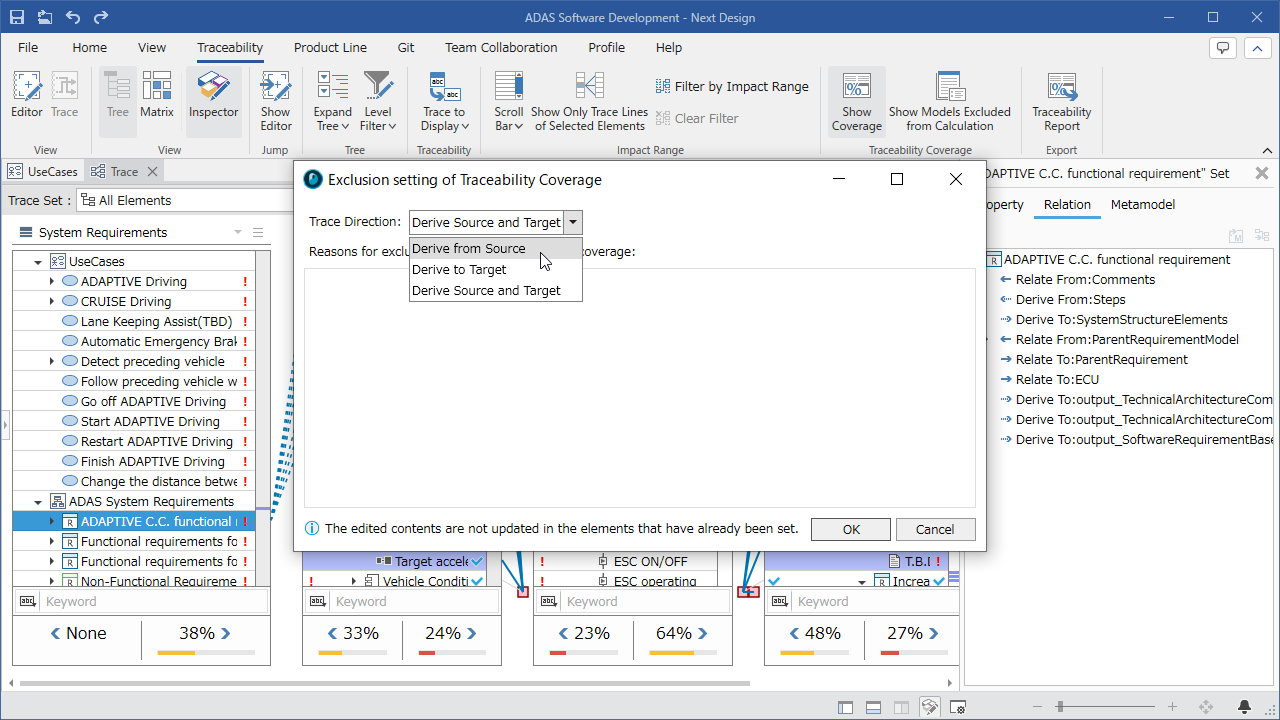
- Right-click the element on the lane you want to exclude from the trace coverage calculation to open the context menu.
- From the context menu, select [Exclude traceability coverage from calculation] to open the [Exclusion Setting of Traceability Coverage] dialog box.
- From the [Trace Direction] options, select the direction you want to exclude from the calculation.
- Enter the reason in the [Reasons for excluding the calculation of trace coverage] text box and click the [OK] button.
- The icon for the side selected in [Trace Direction] will change to an icon indicating that the trace coverage calculation excludes it.
- Click [Traceability] > [Traceability Coverage] > [Show Models Excluded from Calculation] on the ribbon to display a list of excluded elements and the reasons for their exclusion.
- To specify metamodel entities to exclude from the trace coverage calculation, see "Narrowing the Traceability Viewpoints" above.
- To specify the models and relationships included in the trace coverage calculation, see Modeling > Traceability Viewpoints > Saving and Switching Traceability Viewpoints.
Opening and Viewing the Trace View and Model Simultaneously
Viewing a Model from the Trace View
To view a model in a trace view lane in the editor, follow these steps:
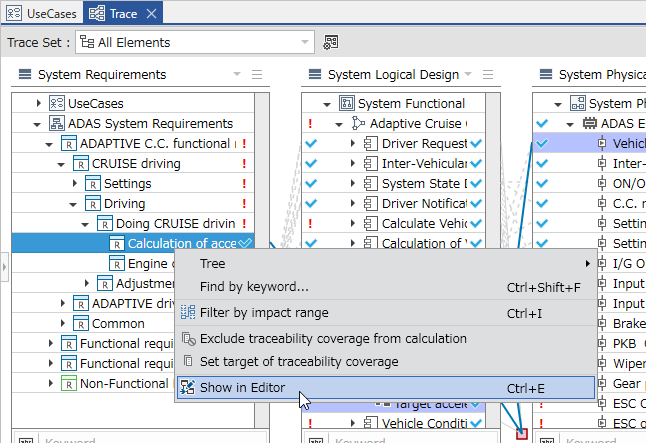
- Select the model in the lane you want to view in the editor, and then select Show in Editor from the context menu.
- The selected model will appear in a fixed tab.